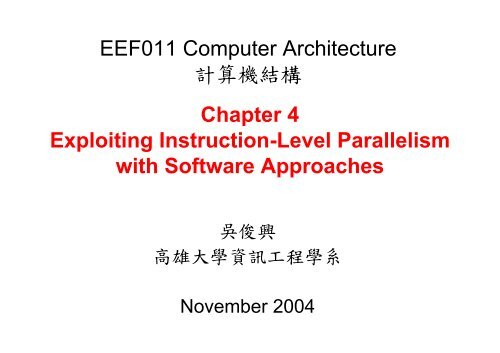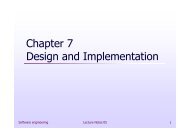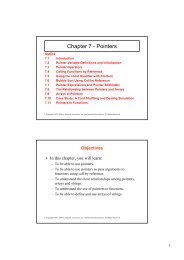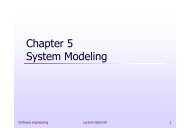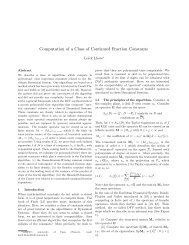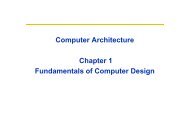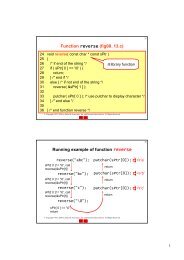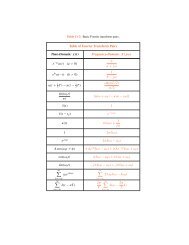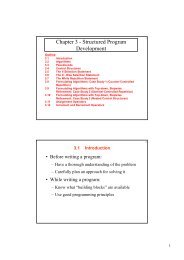Ch4. Exploiting Instruction-Level Parallelism with Software
Ch4. Exploiting Instruction-Level Parallelism with Software
Ch4. Exploiting Instruction-Level Parallelism with Software
Create successful ePaper yourself
Turn your PDF publications into a flip-book with our unique Google optimized e-Paper software.
EEF011 Computer Architecture計 算 機 結 構Chapter 4<strong>Exploiting</strong> <strong>Instruction</strong>-<strong>Level</strong> <strong>Parallelism</strong><strong>with</strong> <strong>Software</strong> Approaches吳 俊 興高 雄 大 學 資 訊 工 程 學 系November 2004
Chapter Overview4.1 Basic Compiler Techniques for Exposing ILP4.2 Static Branch Prediction4.3 Static Multiple Issue: The VLIW Approach4.4 Advanced Compiler Support for ILP4.7 Intel IA-64 Architecture and Itanium Processor2
4.1 Basic Compiler Techniques for Exposing ILP• To avoid a pipeline stall, a dependent instruction must beseparated from the source instruction by a distance inclock cycles equal to the pipeline latency of that sourceinstruction• How can compilers recognize and take advantage of ILP?It depends on– the amount of ILP available in the program– the latencies of the functional units in the pipeline(assume no structural hazards)• Basic compiler technique – Loop UnrollingFigure 4.1 Latencies of FP operations used in this chapters. Assumean integer load latency of 1. Dranches have a delay of one clock cycle.3
Basic Pipeline SchedulingExample: adding a scalar to a vectorWithout any scheduling (10 cycles per loop)Straightforward MIPS codeBasic pipeline scheduling (6 cycles per loop; 3 for loop overhead: DADDUI and BNE)4
Loop UnrollingFour copies of the loop body• Eliminate 3 branch 3 decrements of R1 => improve performance• Require symbolic substitution and simplification• Increase code size substantially => expose more computation that can bescheduled => Gain from scheduling on unrolled loop is larger than originalUnrolling <strong>with</strong>out Scheduling(28 cycles/14 instr.) Unrolling <strong>with</strong> Scheduling(14 cycles)Each L.D has 1 stall, each ADD.D 2, the DADDUI 1,the branch 1, plus 14 instruction issue cycles5
Summary of Loop Unrolling ExampleDecisions and transformations:1. Determine that it was legal to move the SD after the DADDUI and BNE,and find the amount to adjust the SD offset.2. Determine that unrolling the loop would be useful by finding that the loopiterations were independent, except for the loop maintenance code.3. Use different registers to avoid unnecessary constraints that would beforced by using the same registers for different computations.4. Eliminate the extra tests and branches and adjust the loop termination anditeration code.5. Determine that the loads and stores in the unrolled loop can beinterchanged by observing that the loads and stores from differentiterations are independent. This requires analyzing the memory addressesand finding that they do not refer to the same address.6. Schedule the code, preserving any dependences needed to yield the sameresult as the original code.Key requirements: understanding of• how an instruction depends on another• how the instructions can be changed or reordered given the dependences6
Symbolic Substitution to Remove Data DependenceUnrolled but unoptimized<strong>with</strong> extra DADDUI• symbolically computing the intermediatevalues and folding the computation into L.Dand S.D instruction• changing final DADDUI into a decrement by 32Three DADDUI removed7
Register Renaming to Remove Name Dependencegray arrow: data dependenceblack arrow: name dependenceEach loop becomes independentOnly true dependences remain (gray arrow)(<strong>Software</strong> renaming by compilers)8
Loop Unrolling <strong>with</strong> Pipeline SchedulingOriginal loop Loop unrolling only Loop unrolling + pipeline schedulingThree limits to the gains achievable by loop unrolling1.loop overhead• decrease in the amount of overhead amortized <strong>with</strong> each unroll2.code size limitations• larger loops => larger code size growth => larger instruction cache miss rate3.compiler limitations• potential shortfall in registers9
Loop Unrolling and Pipeline Scheduling <strong>with</strong>Static Multiple IssueNo multiple issue (14 cycles)Two issues:1 FP+1 INT/Mem/Branch (12 cycles/5 loops)SummaryMethod# of Instr.Cycles/loopOriginal510Schedule56Unroll 41428/4=7Unroll 4 +Schedule1414/4=3.5Unroll 5 + Schedule+ Multiple Issue1712/5=2.410
4.2 Static Branch Prediction• used where branch behavior is highly predictable atcompile time• architectural feature to support static branch prediction– delayed branchThe instruction in thebranch delay slot isexecuted whether ornot the branch istaken (for zero cyclepenalty)11
Static Branch Prediction for Load StallLD R1, 0(R2) ← Load StallDSUBU R1, R1, R3BEQZ R1, LOR R4, R5, R6DADDU R10, R4, R3L: DADDU R7, R8, R9almostalways takenrarely takenL:LD R1, 0(R2)DADDU R7, R8, R9DSUBU R1, R1, R3BEQZ R1, LOR R4, R5, R6DADDU R10, R4, R3LD R1, 0(R2)OR R4, R5, R6DSUBU R1, R1, R3BEQZ R1, LDADDU R10, R4, R3L: DADDU R7, R8, R9assume it’s safe if mis-predicted12
Static Branch Prediction Schemes• Simplest scheme - predict branch as taken– 34% misprediction rate for SPEC programs (59% to 9%)• Direction-based scheme - predictbackward-going branch as taken andforward-going branch as not taken– Not good for SPEC programs– Overall misprediction rate is not less than 30% to 40%• Profile-based scheme – predict on the basis ofprofile information collected from earlier runs– An individual branch is often highly biased toward taken oruntaken– Changing the input so that the profile is for a different run leadsto only a small change in the accuracy13
Profile-based StaticBranch PredictionMisprediction rate on SPEC92•varying widely: 3% to 24%•in average, 9% for FP programs and15% for integer programsNumber of instructions executedbetween mispredicted branchesavg.FPINTAllstd devTaken30102027Profile1734611085varying widely: dependingon branch frequency andprediction precision14
4.3 Static Multiple Issue: The VLIW ApproachMultiple Issue is the ability of the processor to start more than one instructionin a given cycleFlavor I: Superscalar processors• in-order issue varying number of instructions per clock (1-8)• either statically scheduled (by the compiler) or dynamically scheduled (bythe hardware, Tomasulo)Flavor II: Very Long <strong>Instruction</strong> Word (VLIW)• parallel issue a fixed number of instructions (4-16)- compilers choose instructions to be issued simultaneously• formatted either as one very large instruction or as a fixed issue packet ofsmaller instructions- rigid in early VLIWs• dependency checked and instruction scheduled by the compiler- simplifying hardware (maybe no or simpler dependency check)- complex compiler to uncovered enough parallelism•loop unrolling•local scheduling: operate on a single basic block•global scheduling: may move code across branches• Style: “Explicitly Parallel <strong>Instruction</strong> Computer (EPIC)”- Intel Architecture-64 (IA-64) 64-bit address- Joint HP/Intel agreement in 1999/200015
Unrolled version (x[i]=x[i]+s)Basic VLIW Approach23 operations in 9 clock cycles (2.5 operations per cycle)- 9 cycle for 1 iteration for the baseUnroll 7 iterations in 9 cycles (1.29 cycles per loop)- 2.4 for unrolled 5 and scheduled versionRequire at least 8 FP registers for VLIW- 2 FP registers for the base- 5 FP registers for unrolled 5 and scheduled version22/(5*9)=48.9% of functional units are emptyVLIW: 2 mem’s, 2 FPs, 1 Int/Brx (ignore branch delayed slot)12345678916
Problems <strong>with</strong> Basic VLIW ApproachTechnical problems– increase in code size• unrolling• wasted bits for unused functional units in instruction encodingsolutions: clever encoding, compress– limitations of lockstep operation – synchronization restriction• To keep all functional units (FU) synchronized, a stall in any FU pipelinemust cause the entire processor to stall, i.e. cache stall, exceptionrecent solutions: FU operate more independently, hardware checks allow forunsynchronized execution once instructions are issuedLogistical problem – migration problem– binary code compatibility – recompilation required for different numbersof FUs and unit latenciessolution: object-code translation or emulation17
4.4 Advanced Compiler Support For ILPHow can compilers be smart?1. Produce good scheduling of code2. Determine which loops might contain parallelism3. Eliminate name dependenciesCompilers must be REALLY smart to figure outaliases -- pointers in C are a real problemTwo important ideas:<strong>Software</strong> Pipelining - Symbolic Loop UnrollingTrace Scheduling - Critical Path Scheduling18
Loop-<strong>Level</strong> Dependence and <strong>Parallelism</strong>Loop-carried dependence: data accesses in lateriterations are dependent on data valuesproduced in earlier iterationsstructures analyzed at source level by compilers, such as– loops– array references– induction variable computationsLoop-level parallelism– dependence between two uses of x[i]– dependent <strong>with</strong>in a single iteration, not loop carried– A loop is parallel if it can written <strong>with</strong>out a cycle in thedependences, since the absence of a cycle means that thedependences give a partial ordering on the statements19
P.320 ExampleAssume A, B, and C are distinct, non-overlapping arraysTwo different dependences1.Dependence of S1 is on an earlier iteration of S1S1: A[i+1] depends on A[i], S2: B[i+1] depends on B[i]forces successive iterations to execute in series2.B[i+1] in S2 uses A[i+1] computed by S1 in the same iterationMultiple iterations of the loop could execute in parallel20
P.321 ExampleLoop-carried dependence between S2 (B[i+1]) and S1 (B[i])– not circular: neither statement depends on itself– S1 depends on S2, but S2 does not depend on S1This loop can be made parallelInterchanging– no longer loop carried21
Array Renaming1. True dependences from S1 to S3 and from S1 to S4,based on Y[i]• not loop carried2. antidependence from S1 to S2, based on X[i]3. antidependence from S3 to S4 for Y[i]4. output dependence from S1 to S4, based on Y[i]22
Register Renaming and RecurrenceRenaming: 2nd reference to A can be a reference to the registerRecurrencedependence distance of 523
<strong>Software</strong> Pipelining• Observation: if iterations from loops are independent, thencan get ILP by taking instructions from different iterations• <strong>Software</strong> pipelining: interleave instructions from differentloop iterations– reorganizes loops so that each iteration is made from instructionschosen from different iterations of the original loop (Tomasulo in SW)similar to hardware pipelining24
LOOP: 1 L.D F0,0(R1)2 ADD.D F4,F0,F23 S.D F4,0(R1)4 DADDUI R1,R1,#85 BNE R1,R2,LOOP(5/5)2 RAWs!<strong>Software</strong> PipeliningExample1 L.D F0,0(R1)2 ADD.D F4,F0,F23 S.D F4,0(R1)4 L.D F0,-8(R1)5 ADD.D F4,F0,F26 S.D F4,-8(R1)7 L.D F0,-16(R1)8 ADD.D F4,F0,F29 S.D F4,-16(R1)Before: Unrolled 3 times (11/11)1 L.D F0,0(R1)2 ADD.D F4,F0,F23 S.D F4,0(R1)4 L.D F0,-8(R1)5 ADD.D F4,F0,F26 S.D F4,-8(R1)7 L.D F0,-16(R1)8 ADD.D F4,F0,F29 S.D F4,-16(R1)10 DADDUI R1,R1,#2411 BNE R1,R2,LOOPAfter: <strong>Software</strong> Pipelined (5/11)1 L.D F0,0(R1)2 ADD.D F4,F0,F24 L.D F0,-8(R1)No RAW! (2 WARs)3 S.D F4,0(R1); Stores M[i]5 ADD.D F4,F0,F2; Adds to M[i-1]7 L.D F0,-16(R1); loads M[i-2]10 DADDUI R1,R1,#811 BNE R1,R2,LOOP6 S.D F4,-8(R1)8 ADD.D F4,F0,F29 S.D F4,-16(R1)25
<strong>Software</strong> Pipelining and Loop Unrolling• <strong>Software</strong> pipelining– Can be thought of as symbolic loop unrolling– May use loop-unrolling to figure out how to pipeline the loop• Loop unrolling reduces the overhead of the loop– the branch and counter update code– but every time the inner unrolled loop still need be initiated<strong>Software</strong> pipelining reduces the time when the loop is notrunning at peak speed to once per loop– major advantage: consumes less code space– In practice, compilation using software pipelining is quite difficultthe best performance can come from doing both25 loops <strong>with</strong> 4 unrolled iterations each= 100 iterations26
Global Code Scheduling•Loop unrolling and s/w pipelining mainly work for basic blocks•Global code scheduling: moving instructions across branches–Aims to compact a code fragment <strong>with</strong> internal control structure into theshortest possible sequence that preserves the data and controldependences–Requires estimates of the relative frequency of different paths• shortest possible sequence = shortest sequence for the critical path–Can not guarantee faster codeTwo tasks1. Find the common path2. Move the assignments to B or C27
Trace Scheduling – Critical Path SchedulingTwo steps:• Trace Selection– Trace profiling first– Find likely sequence of basic blocks (trace) of (loop unrolled, staticallypredicted or profile predicted) long sequence of straight-line code– Unwinding frequent path• Trace Compaction– Squeeze trace into few VLIW instructions– Need bookkeeping code in case prediction is wrong– If an instruction can be moved and thereby make the trace executefaster, it is moved• Compiler undoes bad guess (discards values in registers)• Subtle compiler bugs mean wrong answervs. poorer performance; no hardware interlocksA[i] = A[i]+B[i]if(A[i]==0)B[i]=elseXC[i]=A[i] = A[i]+B[i]B[i]=C[i]=if(A[i]!=0) {undoX}28
Unwinding Frequent Path• Assume it’s the inner loop and the likely path• Unwind it four times• Require the compiler to generate and tracethe compensation code29
Superblocks• superblock: single entry point but allow multiple exits–Compacting a superblock is much easier than compacting a trace• Tail duplication–Create a separate block that corresponds to the portion of the traceafter the entry• Superblock approach vs. trace-based approach–Reduce the complexity of bookkeeping and scheduling, but mayenlarge code size–Both may be most appropriate when other techniques fail30
Tail DuplicationCreate a separate block thatcorresponds to the portion ofthe trace after the entry31
Summary - <strong>Software</strong> Approaches to <strong>Exploiting</strong> ILP• Basic block– loop unrolling and basic pipeline scheduling– software pipelining•Trace– trace scheduling and unwinding path• Super block– tail duplication32
4.7 Intel IA-64 and Itanium ProcessorDesigned to benefit VLIW approachIA-64 Register Model•128 64-bit GPR (65 bits actually)•128 82-bit floating-point registers– two extra exponent bits over the standard 80-bit IEEE format•64 1-bit predicate register•8 64-bit branch registers, used for indirect branches•a variety of registers used for system control, etc.•other supports:– register stack frame: like register window in SPARC• current frame pointer (CFM)• register stack engine33
Five Execution Unit Slots in IA-6434
<strong>Instruction</strong> Groups and BundleTwo concepts to achieve the benefits of implicit parallelismand ease of instruction decode• instruction group: a sequence of consecutive instructions<strong>with</strong>out register data dependences– instructions in the group can be executed in parallel– arbitrarily long, but the compiler explicitly indicates the boundary by placing astop• bundle: fixed formatting of multiple instructions (3)– IA-64 instructions are encoded in bundles– 128 bits wide: 5-bit template field and three 41-bit instructions• the template field describes the presence of stops andspecifies types of execution units for each instruction35
24 Possible Template Valuesand Formats8 possible values are reservedStops are indicated by heavy lines36
Example: Unroll x[i]=x[i]+s Seven Times9 bundles21 cycles85% of slots filled(23/27)11 bundles12 cycles70% of slots filled(23/33)37
Some<strong>Instruction</strong>Formats ofIA-64See Textbook orIntel’s manuals formore information38
Predication and Speculation SupportTraditional arch.<strong>with</strong> branch barrierItanium Support for Explicit <strong>Parallelism</strong>instr 1instr 2:brld r1=…use …=r1ld.s r1=…instr 1instr 2:brchk.s r1use …=r1LOAD movedabove branchby compilerld.s r1=…instr 1use …=r1 instr 2:brchk.s useUses movedabove branchby compilerRecovery codeld r1=…use …=r1br39
SummaryChapter 4 <strong>Exploiting</strong> <strong>Instruction</strong>-<strong>Level</strong> <strong>Parallelism</strong><strong>with</strong> <strong>Software</strong> Approaches4.1 Basic Compiler Techniques for Exposing ILP4.2 Static Branch Prediction4.3 Static Multiple Issue: The VLIW Approach4.4 Advanced Compiler Support for ILP4.7 Intel IA-64 Architecture and Itanium Processor40


